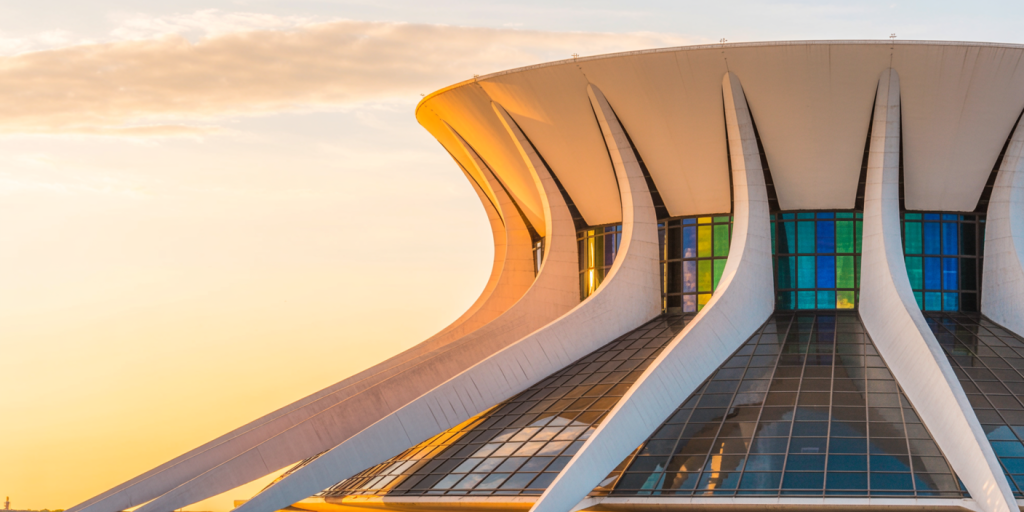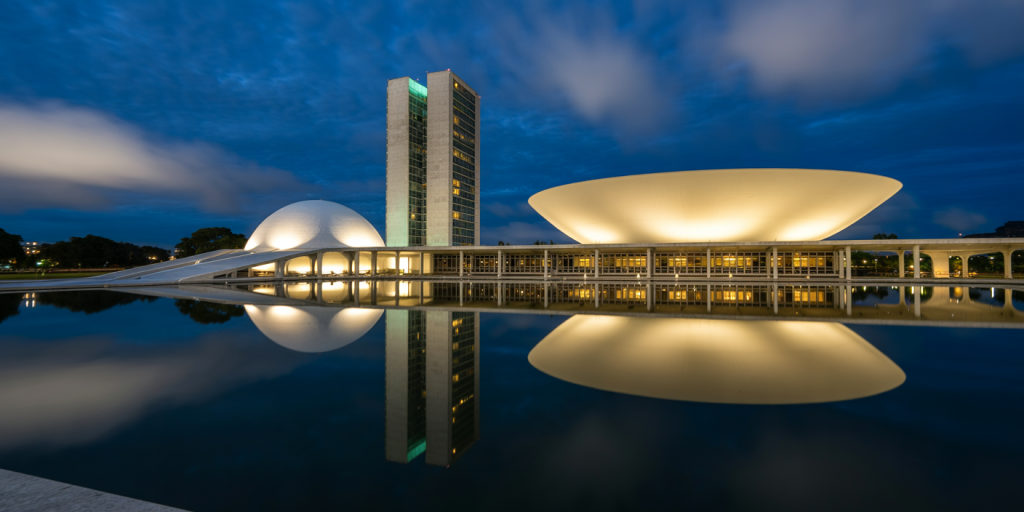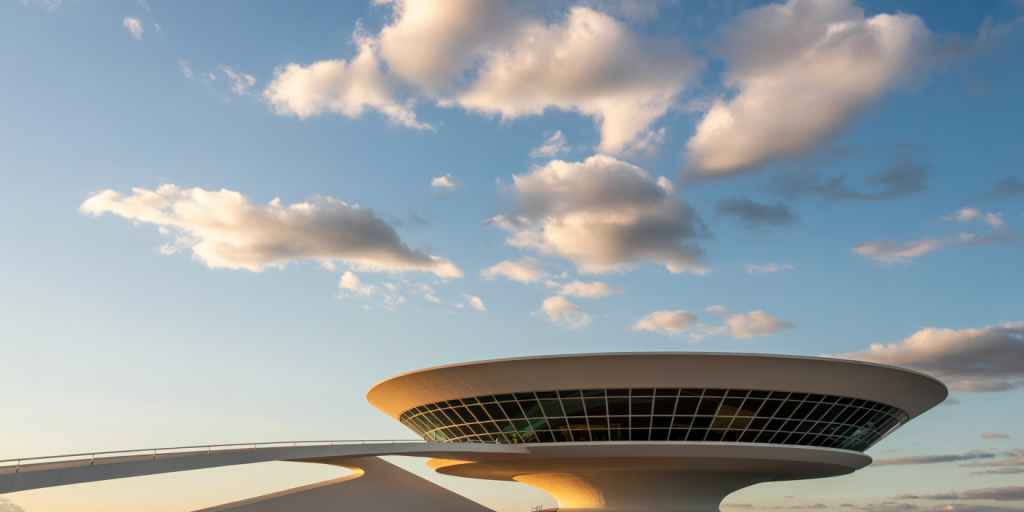Buildings Dream of Skies: Niemeyer’s Slow Architecture
There are structures that sit on the earth with weight, and then there are those that float. Niemeyer’s creations do not simply rise—they exhale. They lean toward the infinite with a grace that defies their material. In a world of rigid verticality, Niemeyer dared to curve.
His buildings dream not of dominance but of communion: with clouds, with winds, with the curves of the human body. Their architecture is slow because it listens. It does not shout for attention; it murmurs to the soul.
Table of Contents
- Curves Drawn from the Breath of Mountains
- The Silence Between Arches
- Concrete as a Skin of Dreams
- The Luminous Patience of the Domes
- Columns That Refuse to March
- The Feminine Line in a Masculine World
- Light That Bends Like Music
- Horizon as Blueprint
- Monumental Intimacy
- The Poetry of Empty Space
- Reflections in Still Water
- Between Sky and Solitude
- The Slow Pulse of Brasília
- Temples of Secular Grace
- Geometry of Desire
- The Gesture Before the Blueprint
- Where the Earth Lifts in Prayer
- Clouds Trapped in Concrete
- A Solitude That Echoes
- Niemeyer’s Shadow on the Sun
Curves Drawn from the Breath of Mountains
Niemeyer once said that he was not attracted to the straight line. In his work, the curve is not only an aesthetic gesture—it is a rebellion, a return to nature, to femininity, to sensuality. His curves are borrowed from hillsides, ocean waves, and the softness of a lover’s shoulder.
They carry a tactile suggestion: we do not want to observe them; we want to touch them. To follow their line with the fingertips, as we do a poem with our breath.
The Silence Between Arches
Arches in Niemeyer’s design are not rigid supports—they are pauses. Between their sweep lies an attentive hush. They allow space to breathe.
One can almost hear the resonance of silence under the broad strokes of his arches, like the echo in a cathedral just before the choir begins. They suggest not containment, but release.
Concrete as a Skin of Dreams
To Niemeyer, concrete was not a limitation but a liberation. He molded it like clay, caressed it into unexpected forms. It became his instrument of tenderness.
The texture of his concrete is not harsh; it is weathered, worn, humane. Like the stone of ancient temples, it carries the fingerprints of intention and time.
The Luminous Patience of the Domes
His domes are not imperial or aggressive. They are meditative. The Cathedral of Brasília, for instance, opens to the heavens like a flower, not a fortress.
Light does not simply fall on these domes; it communes with them. The interplay of shadow and shine invites spiritual suspension, as if the sky itself had bowed in conversation.

Columns That Refuse to March
In a world where columns often imitate the discipline of soldiers, Niemeyer’s do not march. They dance. They twist gently, or lean, or vanish entirely in favor of light.
They suggest balance without severity. Their grace is political: architecture, he implies, does not need to dominate to endure.
The Feminine Line in a Masculine World
Niemeyer has said his architecture was inspired by the female form. But his admiration does not reduce; it elevates. His lines are lyrical, sensual without being voyeuristic.
In the curves of his buildings, one finds not only beauty but strength, softness paired with endurance. It is a feminine presence that softens the sterility of modernism.
Light That Bends Like Music
Light in Niemeyer’s architecture is never accidental. It glides, it dances, it composes. In spaces like the Palácio da Alvorada, light refracts on marble floors like water.
His use of light is akin to melody—a moving thread that guides the eye, sets the rhythm, creates silence where necessary.
Horizon as Blueprint
Niemeyer’s Brasilia is built on the infinite. Roads stretch like brushstrokes on a blank page. The city is not constructed from above, but imagined from afar.
It is an architecture of foresight, of aerial dreams. One does not walk it; one contemplates it from the clouds.
Monumental Intimacy
Despite their scale, Niemeyer’s buildings often feel intimate. The Memorial da América Latina, though vast, folds space in a way that makes solitude possible within grandeur.
The scale does not crush; it holds. It envelopes without devouring.
The Poetry of Empty Space
What Niemeyer excludes is as telling as what he includes. The voids, the open courts, the suspended walkways—they are not gaps, but pages between poems.
Space, to him, is sacred. It allows the visitor to finish the sentence with their own body, their own breath.
Reflections in Still Water
Water is Niemeyer’s co-architect. Reflecting pools extend his designs into dream. They blur the line between solid and ether, presence and echo.
The National Congress building appears to float not by engineering alone, but by poetic trickery: its reflection is its twin soul.

Between Sky and Solitude
Standing beneath one of Niemeyer’s arcades, the viewer feels suspended. Between the weight of earth and the openness of sky, one breathes more slowly.
This pause, this stretch of time, is not accidental. It is the very rhythm of his architecture: slow, like prayer.
The Slow Pulse of Brasília
Brasília is not a city for haste. It is an ode, a wandering. Its avenues do not rush—they meander. Its buildings are pauses, commas in the syntax of space.
The city’s slowness is not inefficiency, but meditation. It is a place where even time feels architectural.
Temples of Secular Grace
Niemeyer’s civic buildings often resemble temples. The curves of auditoriums and museums invite reverence, not for deity, but for democracy, for dialogue.
His architecture ennobles the public space. It offers grace to the ordinary, sanctity to the everyday.
Geometry of Desire
Niemeyer did not follow Euclid blindly. His geometry is intuitive, not prescriptive. Ovals, parabolas, spirals—they appear as gestures, not formulas.
Desire curves. Yearning bends. And so do his buildings. Their shapes are not dictated by rules, but by longing.
The Gesture Before the Blueprint
Often, Niemeyer’s first act was a drawing—a sweeping, fluid line across a blank page. That gesture became law. The building followed.
There is something musical in this process: the architecture as a score, the line as a prelude. Form follows feeling.
Where the Earth Lifts in Prayer
Some of Niemeyer’s forms rise as if the ground itself were stretching upward. The Museu de Arte Contemporânea in Niterói resembles a chalice offered to the sky.
It is not anchored but ascended. Its foundation is faith.
Clouds Trapped in Concrete
Many of Niemeyer’s ceilings seem to hold the weather inside. A curve might resemble a cloud frozen in place. A wall might mimic the swell of sky.
These buildings breathe. They sigh. They hold meteorology in structure.

A Solitude That Echoes
Walking Niemeyer’s spaces often invokes a sense of solitary grandeur. One does not feel alone, but profoundly accompanied by form, by air, by idea.
The echo is not only acoustic, but philosophical. His architecture speaks back.
Niemeyer’s Shadow on the Sun
Even at their brightest, Niemeyer’s buildings cast shadows that feel conscious. These shadows do not obscure; they protect. They are not darkness, but shade.
The sun is allowed to converse with form, not dominate it. In this interplay, time is choreographed.
FAQ
Who was Oscar Niemeyer?
Oscar Niemeyer (1907–2012) was a Brazilian architect and a pioneer of modernist design. Renowned for his use of abstract forms and curves, he played a central role in designing Brasília and many landmarks throughout Brazil and the world.
Why is Niemeyer considered unique?
While many modernists pursued rationality and minimalism, Niemeyer embraced sensuality, curves, and emotion. His work fuses structure with sculpture, engineering with art.
What materials did he favor?
Niemeyer frequently used reinforced concrete, a medium that allowed him the freedom to sculpt organic forms not possible with traditional materials.
Was his work political?
Yes, Niemeyer was a committed leftist and believed in the social function of architecture. His buildings often reflect ideals of equality, openness, and human dignity.
How did he influence global architecture?
His audacious designs challenged conventions, influencing architects worldwide to embrace emotion and sensuality in their structures.
Dreamlines in Stone: Final Notes
Oscar Niemeyer gave architecture a pulse. Where others built with logic, he built with longing. His curves do not conform; they confess. They murmur of clouds, of bodies, of freedom.
To walk beneath his arches is to walk slower. To look at his buildings is to imagine more. He taught us that concrete could dream, that stone could smile, that cities could pause.
And so, even today, his structures stand like sleeping giants, eyes half-closed, still dreaming of skies.
